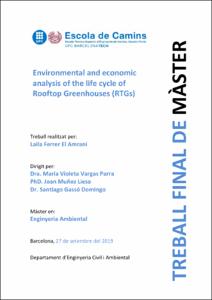Mostra el registre d'ítem simple
Environmental and economic analysis of the life cycle of Rooftop Greenhouses (RTGs)
| dc.contributor | Vargas Parra, María Violeta |
| dc.contributor | Muñoz Liesa, Joan |
| dc.contributor.author | Ferrer El Amrani, Laila |
| dc.contributor.other | Universitat Politècnica de Catalunya. Departament d'Enginyeria Civil i Ambiental |
| dc.date.accessioned | 2020-06-04T10:56:44Z |
| dc.date.available | 2020-06-04T10:56:44Z |
| dc.date.issued | 2019-09-27 |
| dc.identifier.uri | http://hdl.handle.net/2117/189980 |
| dc.description.abstract | Rooftop Greenhouses (RTG) are an opportunity that cities cannot miss. Not only do they allow the development of a new agricultural production model of urban proximity, but also contribute to a low carbon economy, all while taking advantage of the city's spaces that up until now were disused: the roofs of the buildings. The aim of this study is to perform the environmental and economic life cycle assessment of Rooftop Greenhouses (RTGs) in comparison with conventional greenhouses systems by analysing different covering materials to define the optimal RTG scenario. The assessment is divided into: (1) a comparative Life Cycle Assessment (LCA) study between the two reference greenhouses: the RTG and the conventional greenhouse (CG). (2) The assessment of different covering materials– horticulture glass (HG), polycarbonate (PC), polyethylene (PE), polyethylene double-layer and ETFE. (3) A life cycle assessment with the optimal covering material to analyse the environmental burdens optimal scenario for the RTG. Along with the Life Cycle Costing (LCC) assessment, which is applied in order to analyse the economic performance of current and optimal scenario and determine the best option. Following a cradle-to-grave approach, construction, operation and end-of-life stages are included in the study. The functional unit is defined as 1 kg of tomatoes produced over 1 year. The applied LCIA methods are the ReCiPe (hierarchical, midpoint), including the following impact categories: Global Warming (GW), Freshwater Eutrophication (FE), Mineral Resource Scarcity (MRS) and Water Consumption (WC), and the single method Cumulative Energy Demand (CED). For the economic analysis Net present value (NPV) are considered. According to the results obtained in this thesis, results show that the RTG has an environmental impact between 1.3 for WC to 2.7 for GW times higher than a CG. The values obtained for the other indicators are between this interval. The structure of the greenhouse - structure, cover material and auxiliary equipment - represents between 66% and 98% of the total impact for the RTG and, between 60% and 83% for the CG in its whole useful life. Moreover, polyethylene is the material with the lowest environmental impact per greenhouse. The use of ETFE has been valued as a substitute for the current RTG covering, as the replacement with polyethylene does not meet the structural and safety requirements in buildings. Finally, with the new ETFE cover, there is a global improvement for all impact categories. GW stands out for its reduction of 7% of CO2 eq emissions, avoiding 0.05 kg of CO2 eq by kg of tomatoes produced. An important reduction of 10% at CED was also identified, saving 0.84 MJ per kg of tomato. At a cost level, the replacement of the total RTG covering increases the price by 6.8€ per m2. In conclusion, polyethylene can be considered optimal, from an environmental and economic point of view, for conventional greenhouses or non-integrated RTG. However, for the RTG of reference in this work, the optimal cover material is the ETFE, which has similar results than the polyethylene while it “fits” better in the urban environment. |
| dc.language.iso | eng |
| dc.publisher | Universitat Politècnica de Catalunya |
| dc.rights | Attribution-NonCommercial 3.0 Spain |
| dc.rights.uri | http://creativecommons.org/licenses/by-nc/3.0/es/ |
| dc.subject | Àrees temàtiques de la UPC::Enginyeria civil |
| dc.subject.lcsh | Materials -- Testing |
| dc.subject.lcsh | Urban agriculture |
| dc.subject.lcsh | Greenhouses |
| dc.subject.other | RTG |
| dc.subject.other | hivernacle convencional |
| dc.subject.other | LCA |
| dc.subject.other | LCC |
| dc.subject.other | materials de cobertura |
| dc.subject.other | sostenibilitat |
| dc.title | Environmental and economic analysis of the life cycle of Rooftop Greenhouses (RTGs) |
| dc.type | Master thesis |
| dc.subject.lemac | Assaigs de materials |
| dc.subject.lemac | Agricultura urbana |
| dc.subject.lemac | Hivernacles |
| dc.identifier.slug | PRISMA-145649 |
| dc.rights.access | Open Access |
| dc.date.updated | 2020-02-13T11:38:24Z |
| dc.audience.educationlevel | Màster |
| dc.audience.mediator | Escola Tècnica Superior d'Enginyeria de Camins, Canals i Ports de Barcelona |
| dc.audience.degree | MÀSTER UNIVERSITARI EN ENGINYERIA AMBIENTAL (Pla 2014) |


